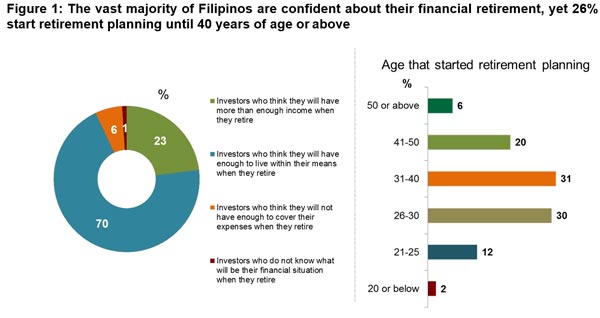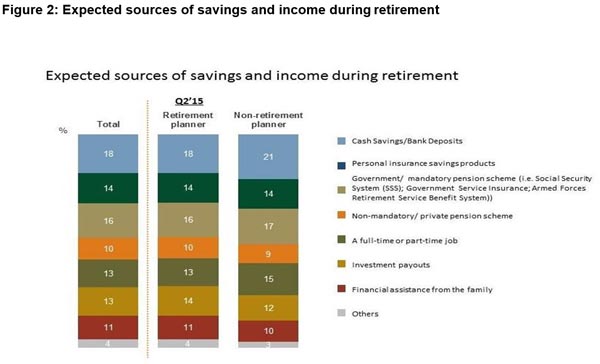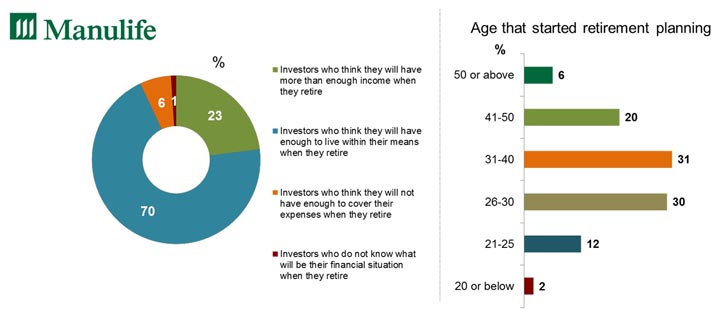Makati City, Philippines – A survey by Manulife has shown that around 93% of Filipino investors are confident about their financial situation in retirement. However, more than a quarter (26%) of those that have begun planning for their retirement started their plans in their 40s or older.

The research carried out for the Manulife Investor Sentiment Index revealed that more than four fifths (82%) of investors have already started retirement planning. However, the average age when Filipinos start their retirement planning is 35.5 years. Furthermore, among those who have not started retirement planning, the average age at which they intend to begin is 41 years.
With more than half of Filipino investors (56%) expecting to retire between the ages of 51 and 60, many may not be devoting enough time to retirement planning.
A 41-year-old Filipino who wants to retire at 60 will therefore only have 19 years to plan and save enough to maintain their current standard of living in retirement – according to Manulife Asset
Management research, the average married couple in the Philippines face a joint retirement duration of almost 21 years*. However, planning to retire at 51 means he or she would have just 10 years to prepare.
“Expenditures are unlikely to fall significantly during retirement and people could live in retirement longer than expected. Investors also need to take into consideration the effect of inflation, which erodes retirement savings by lowering purchasing power and therefore living standards,” said Ryan Charland, President and CEO of Manulife Philippines.
“We encourage investors to plan for retirement early to increase their chances of having enough to support the lifestyle they want once they retire, without having to depend on family or additional sources of income’” Charland added.
The survey also showed investors preparing for their retirement in the Philippines save an average of 12% of their monthly income towards retirement and wealth accumulation. They expect 58% of their retirement income to come from cash savings, insurance saving products and pensions, 13% from a full or part time job and 11% in the form of financial assistance from the family.

The study further found that investors are focusing on building up their pension plans, with almost all respondents (97%) making mandatory contributions and nearly two thirds (64%) making additional voluntary contributions.
“Many Filipino investors recognize the need to supplement their mandatory pension plans to maintain their current standard of living in retirement,” said Aira Gaspar, Chief Investment Officer of Manulife Philippines. “We feel the most effective way to achieve this is to make regular contributions to a portfolio of investments that are diversified across asset classes that match the investor’s risk and return objectives. This approach could reduce the risk of outliving one’s retirement income by maximizing returns potential within one’s risk tolerance levels.”
Gaspar further shared that “Achieving this level of diversification can be a challenge. Therefore, we encourage investors to consider working with a financial advisor who can help them create a retirement saving plan that matches their specific financial and lifestyle goals.”
* Based on the Asia Retirement Duration Model, which forecasts joint retirement durations using average actual retirement ages and husband-wife age gaps for married couples. Source: Manulife Asset Management, Live long and prosper? Retirement and longevity risk. June 2014.
For more findings and related information from the Manulife Investor Sentiment Index in Asia, please visit www.manulife-asia.com.
Liked this post? Follow SwirlingOverCoffee on Facebook.
About Manulife Investor Sentiment Index in Asia
Manulife’s Investor Sentiment Index in Asia is a bi-annual proprietary survey measuring and tracking investors’ views across eight markets in the region on their attitudes towards key asset classes and issues related to personal financial planning. The Index is calculated as a net score (% of “Very good time” and “Good time” minus % of “Bad time” and “Very bad time”) for each asset class. The overall index is calculated as an average of the index figures of asset classes. A positive number means a positive sentiment, zero means a neutral sentiment, and a negative number means negative sentiment.
The Manulife ISI is based on 500 online interviews in each market of Hong Kong, China, Taiwan, Japan, Singapore, Malaysia, Indonesia and the Philippines. Respondents are middle class to affluent investors, aged 25 years and above who are the primary decision maker of financial matters in the household and currently have investment products.
The Manulife ISI is a long-established research series in North America. The Manulife ISI has been measuring investor sentiment in Canada for the past 15 years, and extended this to its John Hancock operation in the U.S. in 2011 and Asia in 2013. Asset classes taken into Manulife ISI Asia calculations are stocks/equities, real estate (primary residence and other investment properties), mutual funds/unit trusts, fixed income investment and cash.
Disclaimer
This material, intended for the exclusive use by the recipients who are allowable to receive this document under the applicable laws and regulations of the relevant jurisdictions, was produced by and the opinions expressed are those of Manulife or any of its affiliates as of September 2015 and are subject to change based on market and other conditions. The information and/or analysis contained in this material have been compiled or arrived at from sources believed to be reliable but Manulife or any of its affiliates does not make any representation as to their accuracy, correctness, usefulness or completeness and does not accept liability for any loss arising from the use hereof or the information and/or analysis contained herein. The information in this document, including statements concerning financial market trends, are based on current market conditions, which will fluctuate and may be superseded by subsequent market events or for other reasons. Manulife or any of its affiliates disclaims any responsibility to update such information. Neither Manulife or its affiliates, nor any of their directors, officers or employees shall assume any liability or responsibility for any direct or indirect loss or damage or any other consequence of any person acting or not acting in reliance on the information contained herein. All overviews and commentary are intended to be general in nature and for current interest. While helpful, these overviews are no substitute for professional tax, investment or legal advice. Clients should seek professional advice for their particular situation. Neither Manulife or any of its affiliates or representatives is providing tax, investment or legal advice. Past performance does not guarantee future results. This material was prepared solely for informational purposes, does not constitute an offer or an invitation by or on behalf of Manulife or any of its affiliates to any person to buy or sell any security and is no indication of trading intent in any fund or account managed by Manulife. No investment strategy or risk management technique can guarantee returns or eliminate risk in any market environment. Issued in Manila by Manulife and its affiliates.
About Manulife Philippines
The Manufacturers Life Insurance Company opened its doors for business in the Philippines in 1907. Since then, Manulife’s Philippine Branch and later The Manufacturers Life Insurance Co. (Phils.), Inc. (Manulife Philippines) has grown to become one of the leading life insurance companies in the country. Manulife Philippines is a wholly-owned domestic subsidiary of Manulife Financial Corporation, among the world’s largest life insurance companies by market capitalization.
About Manulife
Manulife Financial Corporation is a leading international financial services group providing forward-thinking solutions to help people with their big financial decisions. We operate as John Hancock in the United States, and Manulife elsewhere. We provide financial advice, insurance and wealth and asset management solutions for individuals, groups and institutions. At the end of 2014, we had 28,000 employees, 58,000 agents, and thousands of distribution partners, serving 20 million customers. At the end of June 2015, we had $883 billion (US$708 billion) in assets under management and administration, and in the previous 12 months we made more than $22 billion in benefits, interest and other payments to our customers. Our principal operations are in Asia, Canada and the United States where we have served customers for more than 100 years. With our global headquarters in Toronto, Canada, we trade as ‘MFC’ on the Toronto, New York, and the Philippine stock exchanges and under ‘945’ in Hong Kong. Follow Manulife on Twitter @ManulifeNews or visit www.manulife.com.
About Manulife Asset Management
Manulife Asset Management is the global asset management arm of Manulife, providing comprehensive asset management solutions for investors. This investment expertise extends across a broad range of public and private asset classes, as well as asset allocation solutions. As at June 30, 2015, assets under management for Manulife Asset Management were approximately C$390 billion (US$313 billion).
Manulife Asset Management’s public markets units have investment expertise across a broad range of asset classes including public equity and fixed income, and asset allocation strategies. Offices with full investment capabilities are located in the United States, Canada, the United Kingdom, Japan, Hong Kong, Singapore, Taiwan, Indonesia, Thailand, Vietnam, Malaysia, and the Philippines. In addition, Manulife Asset Management has a joint venture asset management business in China, Manulife TEDA. The public markets units of Manulife Asset Management also provide investment management services to affiliates’ retail clients through product offerings of Manulife and John Hancock. John Hancock Asset Management and Declaration Management and Research are units of Manulife Asset Management.
Additional information about Manulife Asset Management may be found at ManulifeAM.com.


